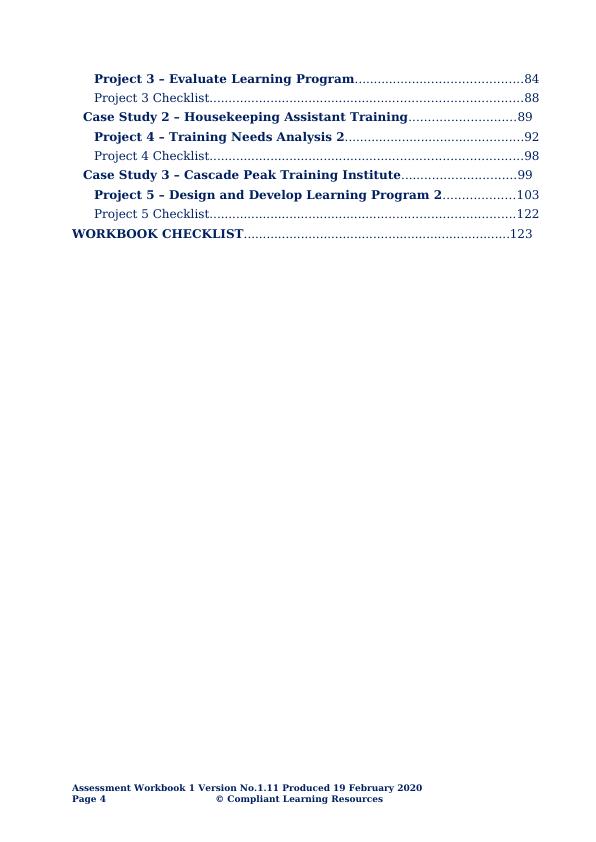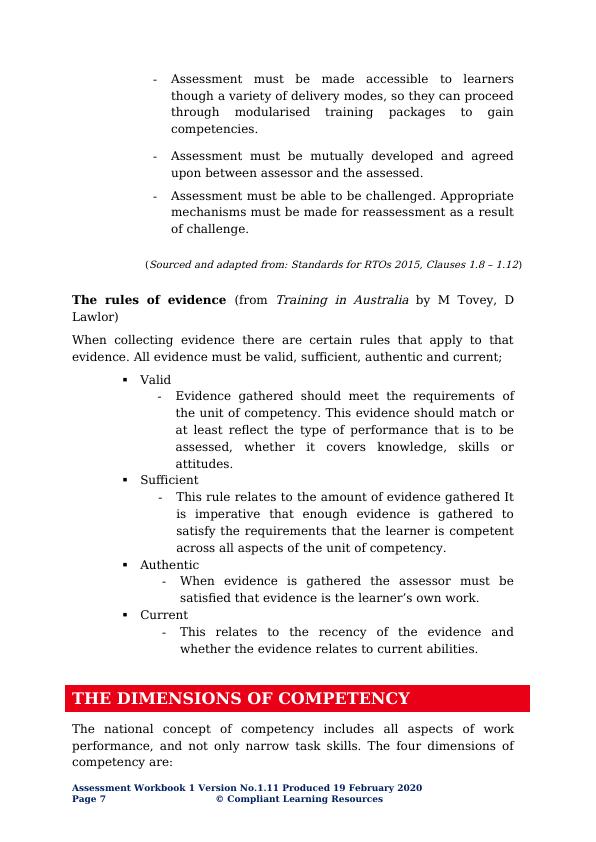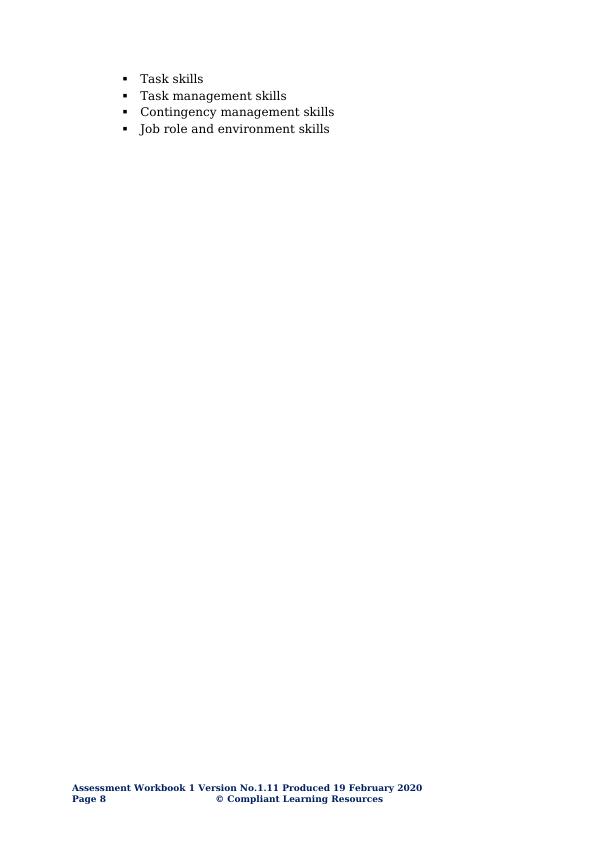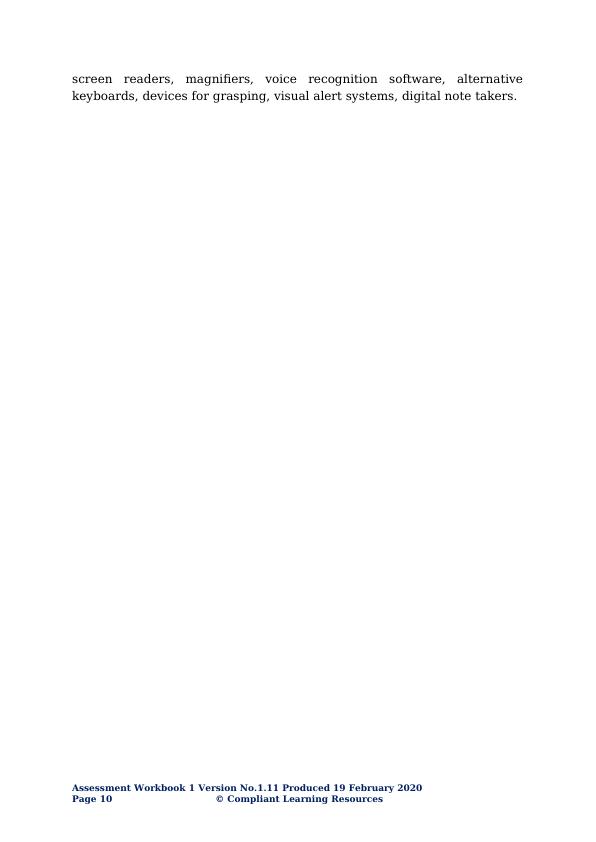Assessment Workbook Cover Sheet - Assignment
Added on 2022-08-30
129 Pages18314 Words32 Views
TAE40116 Certificate IV
in Training and
Assessment
Design Cluster
Version 1.11 Produced 19 February 2020
Copyright © 2016 Compliant Learning Resources. All rights reserved. No part of this publication
may be reproduced or distributed in any form or by any means, or stored in a database or retrieval
system other than pursuant to the terms of the Copyright Act 1968 (Commonwealth), without the
prior written permission of
Compliant Learning Resources
Assessment Workbook 1 Version No.1.11 Produced 19 February 2020
Page 1 © Compliant Learning Resources
Assessment Workbook 1
in Training and
Assessment
Design Cluster
Version 1.11 Produced 19 February 2020
Copyright © 2016 Compliant Learning Resources. All rights reserved. No part of this publication
may be reproduced or distributed in any form or by any means, or stored in a database or retrieval
system other than pursuant to the terms of the Copyright Act 1968 (Commonwealth), without the
prior written permission of
Compliant Learning Resources
Assessment Workbook 1 Version No.1.11 Produced 19 February 2020
Page 1 © Compliant Learning Resources
Assessment Workbook 1

Version control & document history
Date Summary of modifications
made Version
13 April 2016 Version 1 final produced following
assessment validation. v1.0
7 February 2017
Updated Questions and Case
Studies to meet External
Validation recommendations
v1.1
17 May 2017
Updated Questions and Case
Studies to meet updates in
Learner Guide
v1.2
18 July 2017
Updated Questions # 4, 7, 23
Updated mapping to include
Foundation Skills
Restructured Case Studies to
meet Internal Validation
recommendations
v1.3
14 August 2017
Minor corrections in Learning
Program templates
Restructured tasks to meet Oral
Communication foundation skill
v1.4
30 May 2018 Updated link for Implementation
Guide in Project 5 V1.5
13 September
2018
added a comment on Case Study 1
Project 1 Task 1 v1.6
09 September
2019
Paraphrased instructions for
clarity for Knowledge Assessment
Q16, Q37, Q38
V1.7
5 November
2019
Updated ACSF link under
‘Training LLN Analysis’ section V1.8
03 February
2020
Changes in the font style and
color in grey form boxes. V1.9
05 February
2020
Revised guidelines in the Learning
Program Template. V1.10
19 February
2020
Changed filenames of required
documents in Project 4. V1.11
Assessment Workbook 1 Version No.1.11 Produced 19 February 2020
Page 2 © Compliant Learning Resources
Date Summary of modifications
made Version
13 April 2016 Version 1 final produced following
assessment validation. v1.0
7 February 2017
Updated Questions and Case
Studies to meet External
Validation recommendations
v1.1
17 May 2017
Updated Questions and Case
Studies to meet updates in
Learner Guide
v1.2
18 July 2017
Updated Questions # 4, 7, 23
Updated mapping to include
Foundation Skills
Restructured Case Studies to
meet Internal Validation
recommendations
v1.3
14 August 2017
Minor corrections in Learning
Program templates
Restructured tasks to meet Oral
Communication foundation skill
v1.4
30 May 2018 Updated link for Implementation
Guide in Project 5 V1.5
13 September
2018
added a comment on Case Study 1
Project 1 Task 1 v1.6
09 September
2019
Paraphrased instructions for
clarity for Knowledge Assessment
Q16, Q37, Q38
V1.7
5 November
2019
Updated ACSF link under
‘Training LLN Analysis’ section V1.8
03 February
2020
Changes in the font style and
color in grey form boxes. V1.9
05 February
2020
Revised guidelines in the Learning
Program Template. V1.10
19 February
2020
Changed filenames of required
documents in Project 4. V1.11
Assessment Workbook 1 Version No.1.11 Produced 19 February 2020
Page 2 © Compliant Learning Resources

TABLE OF CONTENTS
This is an interactive table of contents. If you are viewing this document
in Acrobat, clicking on a heading will transfer you to that page. If you
have this document open in Word, you will need to hold down the Control
key while clicking for this to work.
TABLE OF CONTENTS...............................................................................3
INTRODUCTION.........................................................................................5
WHAT IS COMPETENCY BASED ASSESSMENT....................................5
Definition of competency...............................................................................6
THE BASIC PRINCIPLES OF ASSESSING NATIONALLY
RECOGNISED TRAINING..........................................................................6
THE DIMENSIONS OF COMPETENCY....................................................7
REASONABLE ADJUSTMENT...................................................................8
THE UNITS OF COMPETENCY...............................................................10
CONTEXT FOR ASSESSMENT................................................................11
ASSESSMENT REQUIREMENTS............................................................11
ASSESSMENT METHODS........................................................................12
RESOURCES REQUIRED FOR ASSESSMENT......................................13
INSTRUCTIONS TO STUDENT...............................................................14
ASSESSMENT WORKBOOK COVER SHEET.........................................15
KNOWLEDGE ASSESSMENT..................................................................16
PRACTICAL ASSESSMENTS...................................................................49
The practical assessment demonstrates the skills required for the
following units of competency covered in this workbook:.......................49
1. TAEDES401 Design and develop learning programs........................49
2. TAEDES402 Use training packages and accredited courses to meet
client needs..............................................................................................49
3. TAELLN411 Address adult language, literacy and numeracy skills
49
Case Study 1 – Catering Assistant Training......................................50
Project 1 – Conduct Training Needs Analysis 1...............................53
Project 1 Checklist..................................................................................63
Project 2 – Design and Develop Learning Program 1.....................64
Supplementary Task 2: Marking Result Form........................................82
Project 2 Checklist..................................................................................83
Assessment Workbook 1 Version No.1.11 Produced 19 February 2020
Page 3 © Compliant Learning Resources
This is an interactive table of contents. If you are viewing this document
in Acrobat, clicking on a heading will transfer you to that page. If you
have this document open in Word, you will need to hold down the Control
key while clicking for this to work.
TABLE OF CONTENTS...............................................................................3
INTRODUCTION.........................................................................................5
WHAT IS COMPETENCY BASED ASSESSMENT....................................5
Definition of competency...............................................................................6
THE BASIC PRINCIPLES OF ASSESSING NATIONALLY
RECOGNISED TRAINING..........................................................................6
THE DIMENSIONS OF COMPETENCY....................................................7
REASONABLE ADJUSTMENT...................................................................8
THE UNITS OF COMPETENCY...............................................................10
CONTEXT FOR ASSESSMENT................................................................11
ASSESSMENT REQUIREMENTS............................................................11
ASSESSMENT METHODS........................................................................12
RESOURCES REQUIRED FOR ASSESSMENT......................................13
INSTRUCTIONS TO STUDENT...............................................................14
ASSESSMENT WORKBOOK COVER SHEET.........................................15
KNOWLEDGE ASSESSMENT..................................................................16
PRACTICAL ASSESSMENTS...................................................................49
The practical assessment demonstrates the skills required for the
following units of competency covered in this workbook:.......................49
1. TAEDES401 Design and develop learning programs........................49
2. TAEDES402 Use training packages and accredited courses to meet
client needs..............................................................................................49
3. TAELLN411 Address adult language, literacy and numeracy skills
49
Case Study 1 – Catering Assistant Training......................................50
Project 1 – Conduct Training Needs Analysis 1...............................53
Project 1 Checklist..................................................................................63
Project 2 – Design and Develop Learning Program 1.....................64
Supplementary Task 2: Marking Result Form........................................82
Project 2 Checklist..................................................................................83
Assessment Workbook 1 Version No.1.11 Produced 19 February 2020
Page 3 © Compliant Learning Resources

Project 3 – Evaluate Learning Program............................................84
Project 3 Checklist..................................................................................88
Case Study 2 – Housekeeping Assistant Training............................89
Project 4 – Training Needs Analysis 2...............................................92
Project 4 Checklist..................................................................................98
Case Study 3 – Cascade Peak Training Institute..............................99
Project 5 – Design and Develop Learning Program 2...................103
Project 5 Checklist................................................................................122
WORKBOOK CHECKLIST......................................................................123
Assessment Workbook 1 Version No.1.11 Produced 19 February 2020
Page 4 © Compliant Learning Resources
Project 3 Checklist..................................................................................88
Case Study 2 – Housekeeping Assistant Training............................89
Project 4 – Training Needs Analysis 2...............................................92
Project 4 Checklist..................................................................................98
Case Study 3 – Cascade Peak Training Institute..............................99
Project 5 – Design and Develop Learning Program 2...................103
Project 5 Checklist................................................................................122
WORKBOOK CHECKLIST......................................................................123
Assessment Workbook 1 Version No.1.11 Produced 19 February 2020
Page 4 © Compliant Learning Resources

INTRODUCTION
Assessment is a difficult process – we understand this and have
developed a range of assessment kits, such as this, to facilitate a
seamless process for both the assessor and the learner being assessed.
There are a number of characteristics of assessment, ranging fromsubjective assessment (which is based on opinions and feelings), toobjective assessment (which is based clearly on defined processes and
specific standards). Nearly all assessment involves a mixture of both
types of assessment because it is almost impossible to eradicate the
subjectivity humans carry into the process of assessing. The goal in
developing and implementing these assessment kits is to work towards
the objective end as far as possible and to reduce the degree of opinions
and feelings present.
WHAT IS COMPETENCY BASED ASSESSMENT
The features of a competency based assessment system are:
It is focused on what learners can do and whether it meets the
criteria specified by industry as competency standards.
Assessment should mirror the environment the learner will
encounter in the workplace.
Assessment criteria should be clearly stated to the learner at the
beginning of the learning process.
Assessment should be holistic. That is, it aims to assess as many
elements and/or units of competency as is feasible at one time.
In competency assessment, a learner receives one of only two
outcomes – competent or not yet competent.
The basis of assessment is in applying knowledge for some
purpose. In a competency system, knowledge for the sake of
knowledge is seen to be ineffectual unless it assists a person to
perform a task to the level required in the workplace.
The emphasis in assessment is on assessable outcomes that are
clearly stated for the trainer and learner. Assessable outcomes
are tied to the relevant industry competency standards where
these exist. Where such competencies do not exist, the outcomes
are based upon those identified in a training needs analysis.
Assessment Workbook 1 Version No.1.11 Produced 19 February 2020
Page 5 © Compliant Learning Resources
Assessment is a difficult process – we understand this and have
developed a range of assessment kits, such as this, to facilitate a
seamless process for both the assessor and the learner being assessed.
There are a number of characteristics of assessment, ranging fromsubjective assessment (which is based on opinions and feelings), toobjective assessment (which is based clearly on defined processes and
specific standards). Nearly all assessment involves a mixture of both
types of assessment because it is almost impossible to eradicate the
subjectivity humans carry into the process of assessing. The goal in
developing and implementing these assessment kits is to work towards
the objective end as far as possible and to reduce the degree of opinions
and feelings present.
WHAT IS COMPETENCY BASED ASSESSMENT
The features of a competency based assessment system are:
It is focused on what learners can do and whether it meets the
criteria specified by industry as competency standards.
Assessment should mirror the environment the learner will
encounter in the workplace.
Assessment criteria should be clearly stated to the learner at the
beginning of the learning process.
Assessment should be holistic. That is, it aims to assess as many
elements and/or units of competency as is feasible at one time.
In competency assessment, a learner receives one of only two
outcomes – competent or not yet competent.
The basis of assessment is in applying knowledge for some
purpose. In a competency system, knowledge for the sake of
knowledge is seen to be ineffectual unless it assists a person to
perform a task to the level required in the workplace.
The emphasis in assessment is on assessable outcomes that are
clearly stated for the trainer and learner. Assessable outcomes
are tied to the relevant industry competency standards where
these exist. Where such competencies do not exist, the outcomes
are based upon those identified in a training needs analysis.
Assessment Workbook 1 Version No.1.11 Produced 19 February 2020
Page 5 © Compliant Learning Resources

DEFINITION OF COMPETENCY
Assessment in this context can be defined as:
The fair, valid, reliable and flexible gathering and recording of
evidence to support judgement on whether competence has been
achieved. Skills and knowledge (developed either in a structured
learning situation, at work, or in some other context) are assessed
against national standards of competence required by industry,
rather than compared with the skills and knowledge of other
learners.
THE BASIC PRINCIPLES OF ASSESSING
NATIONALLY RECOGNISED TRAINING
Developing and conducing assessment, in an Australian vocational
education and training context, is founded on a number of basic
conventions:
The principles of assessment
Assessment must be valid
- Assessment must include the full range of skills and
knowledge needed to demonstrate competency.
- Assessment must include the combination of knowledge
and skills with their practical application.
- Assessment, where possible, must include judgements
based on evidence drawn from a number of occasions
and across a number of contexts.
Assessment must be reliable
- Assessment must be reliable and must be regularly
reviewed to ensure that assessors are making decisions
in a consistent manner.
- Assessors must be trained in national competency
standards for assessors to ensure reliability.
Assessment must be flexible
- Assessment, where possible, must cover both the on
and off-the-job components of training within a course.
- Assessment must provide for the recognition of
knowledge, skills and attitudes regardless of how they
have been acquired.
Assessment Workbook 1 Version No.1.11 Produced 19 February 2020
Page 6 © Compliant Learning Resources
Assessment in this context can be defined as:
The fair, valid, reliable and flexible gathering and recording of
evidence to support judgement on whether competence has been
achieved. Skills and knowledge (developed either in a structured
learning situation, at work, or in some other context) are assessed
against national standards of competence required by industry,
rather than compared with the skills and knowledge of other
learners.
THE BASIC PRINCIPLES OF ASSESSING
NATIONALLY RECOGNISED TRAINING
Developing and conducing assessment, in an Australian vocational
education and training context, is founded on a number of basic
conventions:
The principles of assessment
Assessment must be valid
- Assessment must include the full range of skills and
knowledge needed to demonstrate competency.
- Assessment must include the combination of knowledge
and skills with their practical application.
- Assessment, where possible, must include judgements
based on evidence drawn from a number of occasions
and across a number of contexts.
Assessment must be reliable
- Assessment must be reliable and must be regularly
reviewed to ensure that assessors are making decisions
in a consistent manner.
- Assessors must be trained in national competency
standards for assessors to ensure reliability.
Assessment must be flexible
- Assessment, where possible, must cover both the on
and off-the-job components of training within a course.
- Assessment must provide for the recognition of
knowledge, skills and attitudes regardless of how they
have been acquired.
Assessment Workbook 1 Version No.1.11 Produced 19 February 2020
Page 6 © Compliant Learning Resources

- Assessment must be made accessible to learners
though a variety of delivery modes, so they can proceed
through modularised training packages to gain
competencies.
- Assessment must be mutually developed and agreed
upon between assessor and the assessed.
- Assessment must be able to be challenged. Appropriate
mechanisms must be made for reassessment as a result
of challenge.
(Sourced and adapted from: Standards for RTOs 2015, Clauses 1.8 – 1.12)
The rules of evidence (from
Training in Australia by M Tovey, D
Lawlor)
When collecting evidence there are certain rules that apply to that
evidence. All evidence must be valid, sufficient, authentic and current;
Valid
- Evidence gathered should meet the requirements of
the unit of competency. This evidence should match or
at least reflect the type of performance that is to be
assessed, whether it covers knowledge, skills or
attitudes.
Sufficient
- This rule relates to the amount of evidence gathered It
is imperative that enough evidence is gathered to
satisfy the requirements that the learner is competent
across all aspects of the unit of competency.
Authentic
- When evidence is gathered the assessor must be
satisfied that evidence is the learner’s own work.
Current
- This relates to the recency of the evidence and
whether the evidence relates to current abilities.
THE DIMENSIONS OF COMPETENCY
The national concept of competency includes all aspects of work
performance, and not only narrow task skills. The four dimensions of
competency are:
Assessment Workbook 1 Version No.1.11 Produced 19 February 2020
Page 7 © Compliant Learning Resources
though a variety of delivery modes, so they can proceed
through modularised training packages to gain
competencies.
- Assessment must be mutually developed and agreed
upon between assessor and the assessed.
- Assessment must be able to be challenged. Appropriate
mechanisms must be made for reassessment as a result
of challenge.
(Sourced and adapted from: Standards for RTOs 2015, Clauses 1.8 – 1.12)
The rules of evidence (from
Training in Australia by M Tovey, D
Lawlor)
When collecting evidence there are certain rules that apply to that
evidence. All evidence must be valid, sufficient, authentic and current;
Valid
- Evidence gathered should meet the requirements of
the unit of competency. This evidence should match or
at least reflect the type of performance that is to be
assessed, whether it covers knowledge, skills or
attitudes.
Sufficient
- This rule relates to the amount of evidence gathered It
is imperative that enough evidence is gathered to
satisfy the requirements that the learner is competent
across all aspects of the unit of competency.
Authentic
- When evidence is gathered the assessor must be
satisfied that evidence is the learner’s own work.
Current
- This relates to the recency of the evidence and
whether the evidence relates to current abilities.
THE DIMENSIONS OF COMPETENCY
The national concept of competency includes all aspects of work
performance, and not only narrow task skills. The four dimensions of
competency are:
Assessment Workbook 1 Version No.1.11 Produced 19 February 2020
Page 7 © Compliant Learning Resources

Task skills
Task management skills
Contingency management skills
Job role and environment skills
Assessment Workbook 1 Version No.1.11 Produced 19 February 2020
Page 8 © Compliant Learning Resources
Task management skills
Contingency management skills
Job role and environment skills
Assessment Workbook 1 Version No.1.11 Produced 19 February 2020
Page 8 © Compliant Learning Resources

End of preview
Want to access all the pages? Upload your documents or become a member.
Related Documents
Design Cluster - Assessment Workbook 1lg...
|136
|20575
|78
Design Cluster - Assessment Workbook 1lg...
|148
|23566
|173
Assessment Workbook 1 - TAE40116 Certificate IV in Training and Assessmentlg...
|170
|28119
|359
Assessment Workbook 1lg...
|138
|19185
|79
Case Management Part II: Working with Peer Case Workerslg...
|122
|17967
|67
Children’s Health and Safety in Early Childhood Education and Carelg...
|151
|24108
|457
